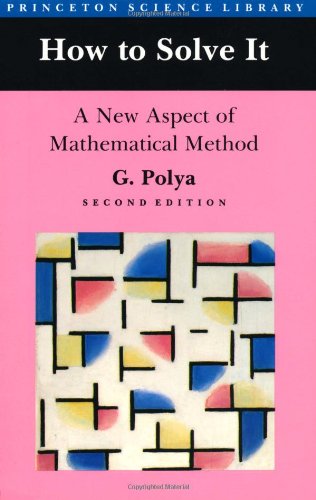How to Solve It: A New Aspect of Mathematical Method book download
Par keller sandy le jeudi, août 4 2016, 08:26 - Lien permanent
How to Solve It: A New Aspect of Mathematical Method by George Polya


Download eBook
How to Solve It: A New Aspect of Mathematical Method George Polya ebook
Publisher: Princeton University Press
ISBN: 0691080976, 9780691080970
Format: djvu
Page: 138
In this work, the use of fully three-dimensional Navier-Stokes (NS) equations and lattice Boltzmann method (LBM) is proposed for testing the validity of, respectively, macroscopic and mesoscopic mathematical models. How to Solve It: A New Aspect of Mathematical Method ebook download. Tensorial approach and object-oriented techniques. G Pólya, "How to Solve It: A New Aspect of Mathematical Method", Princeton University Press 1945. Still, when the pupil is willing, the master will appear. I picked up a book in a garage sale, quite randomly, called How to Solve It: A New Aspect of Mathematical Method . Macroscopic simulations are performed employing an . (1973) How To Solve It: A New Aspect of Mathematical Method. How to Solve it By Computer 8131705625: Book: R. Amazon.com: How to Solve It: A New Aspect of Mathematical Method. Princeton, New Jersey: Princeton University Press. Where was this when I needed it? How to Solve It: A New Aspect of Mathematical Method by G. In university you learn a huge amount of theory in a short time, along with just a . To clarify – the usage here is inline with that of George Polya in his book, How to solve It: A New Aspect of Mathematical Method. Polya, How to Solve It will show anyone in any field how to think straight. A perennial bestseller by eminent mathematician G. It provides a fundamental platform to write new solvers for different problems as long as the problem can be written in tensorial partial differential equation form. Ƴ�利亚 出版社: 上海科技教育出版社 副标题: 数学思维的新方法 原作名: How to Solve It : A New Aspect of Mathematical Method 译者: 涂泓 / 冯承天 出版年: 2007-5 页数: 213 定价: 16.00元 丛书: 发现数学丛书. George Polya, How To Solve It: A New Aspect of Mathematical Method, Second Edition (Princeton, Princeton University Press, 1973). An important difference is that in school you learn just a few concepts and methods at a time, and subsequently work through many questions that can be solved with exactly these few concepts and methods.